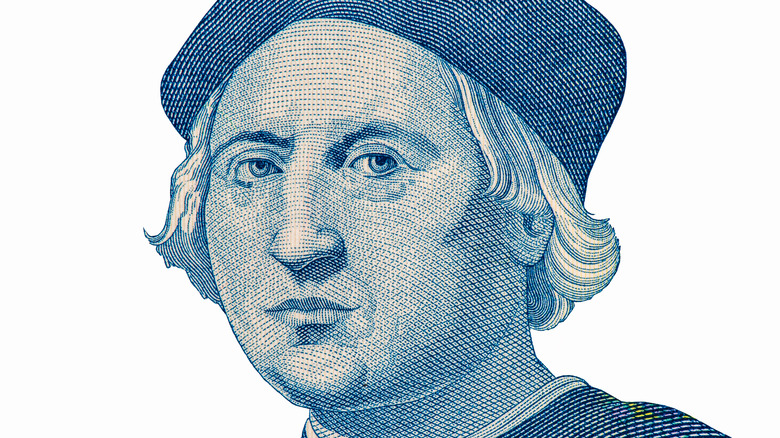The Connection Between Christopher Columbus And Cantaloupe
On a hot, sweaty day, few treats hit as hard as a sweet, refreshing cantaloupe. According to Healthline, cantaloupe is packed with beta-carotene, a carotenoid that promotes eye, red blood cell, and immune system health. You can even eat the seeds.
According to New World Encyclopedia, the word "cantaloupe" has etymological roots in the 18th-century French word "cantaloup," which refers to the area near Rome (Cantalupo) where the Pope lived. "Cantalupo" itself means "howling wolves," which is a pretty rad name for something as unassuming as a melon. Story has it that cantaloupes were first grown on the Papal estate strictly for the religious higher-ups to enjoy before expanding to markets for the rest of us. Although cantaloupes were cultivated in the Mediterranean, it's likely that they first originated in Persia or India. Still, the exact origin of the melon is still not conclusively determined. PlantVillage maintains that "Cucumis melo" has origins in East and Northeast Africa.
Regardless of where it grew first, cantaloupe first appears in recorded English history in Philip Miller's 1739 "Gardener's Dictionary," (via Bon Appétit). Miller describes "Cantaleupt Melon" as having "Flesh... of a rich vinous Flavour." Miller also compares it to the musk melon ("Muske Nectarin"), writing "both smelleth and eateth as if the fruit were steeped in Muske." But, believe it or not, we might have Christopher Columbus to thank for bringing the melon to America. (Which is, of course, great — but also, yikes.)
Explorers gotta eat, too
Rumor has it that Christopher Columbus was the first person to bring cantaloupe (aka muskmelon, sweet melon, rock melon, or sanspek) to America in 1494, says Minneopa Orchards. Columbus is the Italian explorer credited with accidentally discovering the Americas while trying to find a direct trade route via sea from Europe to Asia, per History.
In 1492, Columbus sailed all throughout the Caribbean, stopping at many islands along the way and sampling the natural flora and fauna as well as the cultural art of each place he encountered. By 1493, after landing on the island of Hispaniola and subsequently enslaving its generous and welcoming people, Columbus returned to Spain before embarking again on another wealth and power-driven exploration. Timeline-wise, though, the attribution lines up; it's definitely possible that Columbus could have been the first to bring cantaloupe to the New World.
This isn't the explorer's only agricultural contribution to the Americas, either. Columbus is also historically rumored to have first introduced honeydew seeds to the U.S. and fostered their agricultural spread, per Produce Blue Book. Of course, given the fact that Columbus was Italian, commissioned for travel by Spain, and aspired to sail for Portugal (per History), it's curious to consider why cantaloupe has a French name. (The explorer isn't famous for his awesome ability to correctly identify things, after all.)

